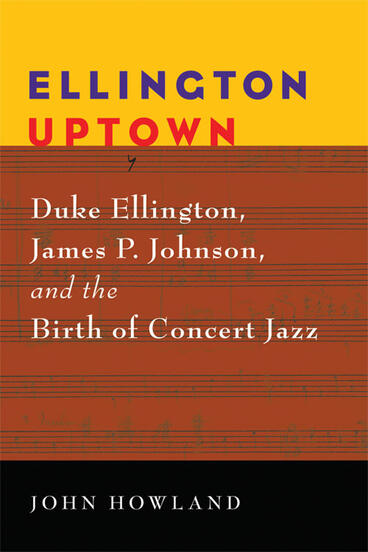Ellington Uptown
Duke Ellington, James P. Johnson, and the Birth of Concert Jazz
Explores a little-discussed yet truly hybrid American musical tradition lost between the canons of authentic jazz and classical music
Description
The story of the African American contributions to the symphonic jazz vogue of the 1920s through the 1940s.
During the early decades of the twentieth century symphonic jazz involved an expansive family of music that emulated, paralleled, and intersected the jazz tradition. Though now largely forgotten, symphonic jazz was both a popular music---arranging tradition and a repertory of hybrid concert works, both of which reveled in the mildly irreverent interbreeding of white and black and high and low music. While the roots of symphonic jazz can be traced to certain black ragtime orchestras of the teens, the idiom came to maturation in the music of 1920s white dance bands.
Through a close examination of the music of Duke Ellington and James P. Johnson, Ellington Uptown uncovers compositions that have usually fallen in the cracks between concert music, jazz, and popular music. It also places the concert works of these two iconic figures in context through an investigation both of related compositions by black and white peers and of symphonic jazz---style arrangements from a diverse number of early sound films, Broadway musicals, Harlem nightclub floor shows, and select interwar radio programs.
Both Ellington and Johnson were part of a close-knit community of several generations of Harlem musicians. Older figures like Will Marion Cook, Will Vodery, W. C. Handy, and James Reese Europe were the generation of black musicians that initially broke New York entertainment's racial barriers in the first two decades of the century. By the 1920s, Cook, Vodery, and Handy had become mentors to Harlem's younger musicians. This generational connection is a key for understanding Johnson’s and Ellington's ambitions to use the success of Harlem's white-oriented entertainment trade as a springboard for establishing a black concert music tradition based on Harlem jazz and popular music.
John Howland is Assistant Professor of Music at Rutgers University and the cofounder and current editor-in-chief of the journal Jazz Perspectives. This work has been supported through several prestigious awards, including the Lloyd Hibberd Publication Endowment Fund of the American Musicological Society.
Supplemental Materials
Sample Audio Tracks
Author John Howland has selected a series of musical compositions especially for this site, that he feels help to identify some important trends in Duke Ellington and James P. Johnson's music. Read the descriptions below and click the links to hear a clip of each song, including one exclusive never-released clip from the Johnson estate.
Duke Ellington, "Black" from Black, Brown & Beige, performed live at Carnegie Hall, January 23, 1943
NOTE: Duke Ellington's 45-minute, three-movement concert work, Black, Brown and Beige, which is subtitled A Tone Parallel to the History of the Negro in America, was premiered at his orchestra's Carnegie Hall debut and represents Ellington's most ambitious effort at combining his interest in symphonic-length composition and subtle social commentary on both American race relations and the art of African American popular music.
Duke Ellington, "New World a Comin'," performed live at Carnegie Hall, December 11, 1943
NOTE: As the central extended composition at Ellington's second annual Carnegie Hall concert, the 1943 quasi-piano concerto New World a Comin' both promoted his lifelong social hopes for racial equality and represented his most self-consciously rhapsodic piano composition.
Duke Ellington, A Tone Parallel to Harlem (Harlem Suite), from the 1951 album Ellington Uptown
NOTE: While Duke Ellington's 1951 big band composition A Tone Parallel to Harlem was designed as a musical travelogue of the composer's beloved Harlem community, the subsequent big-band-plus-symphony orchestration (by Luther Henderson) of this masterful 14-minute composition also became Ellington's most widely performed "symphonic" work.
James P. Johnson, Yamekraw: A Negro Rhapsody, performed by Marcus Roberts (piano) with orchestra
NOTE: As the first major black concert jazz composition, and as a work that was notably composed by the father of Harlem stride piano, James P. Johnson's 1927 Yamekraw: A Negro Rhapsody opens a valuable window on the vibrant legacy of the 1920s symphonic jazz idiom as it existed beyond the George Gershwin and Paul Whiteman circle.
James P. Johnson, Jazzamine Concerto, recorded by James P. Johnson as a piano solo in 1945
NOTE: James P. Johnson's 1945 solo piano recording of his 1934 piano-and-orchestra Jazzamine Concerto (a.k.a. Concerto Jazz a Mine) ideally illustrates his personal vision for translating the Harlem stride piano idiom to the compositional ideals of the concert hall.
Movement IV, "In a Baptist Mission," from James P. Johnson's Harlem Symphony, premiere performance by the Brooklyn Civic Orchestra, Dr. Paul Kosok, conductor, March 11, 1939, broadcast over WYNC, New York. Property of the James P. Johnson Estate and the James P. Johnson Foundation, Riverside, CA.
NOTE: This rare transcription recording captures the vibrant premiere performance of the Harlem Symphony, James P. Johnson's rich musical travelogue of the Harlem community and his most-performed concert work.
News, Reviews, Interviews
Listen: Interview on Night Lights | 3/1/2010
Listen: UMP Author Podcast Series: John Howland | mp3 | 4/1/2009
Listen: Interview on WMOT | 6/24/2009
Read: Author Interview | Night Lights | 3/1/2010
Read: Review on Jazz Times | 10/15/2009
Read: Review on All About Jazz | 8/10/2009
Read: Review on Impose | 7/7/2009
Read: Q&A with John Howland (PDF)
Read: Review in Notes: Quarterly Journal of the Music Library Association (PDF) | March 2011

